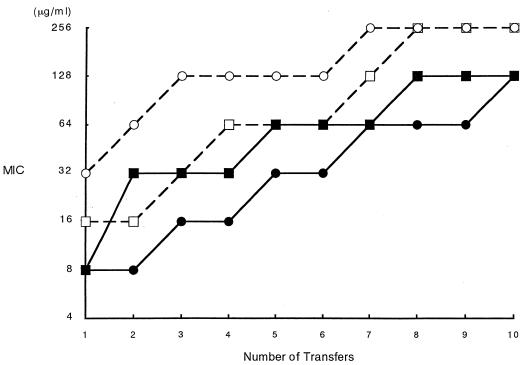Clinical isolates of mupirocin-resistant Staphylococcus aureus were first reported in 1987 (4), and low-level resistance was reported to be conferred by the chromosomal location of the mupA gene (5) in some but not all strains (6). On the other hand, low-level resistance in S. aureus emerged as the result of independent, spontaneous mutational events by exposure to increasing concentrations of mupirocin. In the present study, we examined the mupA gene for molecular heterogeneity in S. aureus strains with low-level resistance to mupirocin (L-Mup) which were isolated from London, United Kingdom, and different geographic regions within the Tohoku area in Japan. A total of 25 L-Mup strains were obtained from individual patients at King's College Hospital, London. Three hundred methicillin-resistant Staphylococcus aureus (MRSA) strains were collected from 14 hospitals in different geographic regions of the Tohoku area in Japan, and two of the 300 MRSA strains (J7022 and J7023) were L-Mup. All strains were collected from different patients and tested for low-level resistance by the disk diffusion assay using 5- and 200-μg-mupirocin disks (1). Genomic DNAs were extracted from all strains by boiling as previously described (3). The mupA gene was amplified using two oligonucleotide primer pairs. Mup1 and Mup2 were as previously described (5). The primers used were Mup3 (5′-TTCGGATAGTGCTCCATG-3′) and Mup4 (5′-CCCCAGTTACACCGATAT-3′), which amplified a 1.1-kb product from the mupA gene (nucleotides 2315 to 3408 [2]). PCR amplification of each fragment was performed using the reaction mixture reported previously (5). The amplification conditions were as follows: for fragment 1 (1.65 kb), 30 cycles of 1 min at 94°C, 2 min at 55°C, and 3 min at 72°C, with a final extension (3 min at 72°C); for fragment 2 (1.1 kb), 30 cycles at 92°C for 1 min, 55°C for 1 min, and 72°C for 2 min. We were unable to detect the mupA gene in any of the 25 L-Mup S. aureus strains from London. However, each of the 1.65- and 1.1-kb internal mupA gene fragments were amplifications of one L-Mup MRSA strain (J7023) in Japan. To characterize potential mutations of the mupA gene, J7023 was used. The sequence of the 3,072-bp (a complete open reading frame A) internal mupA gene fragment was determined by dye terminator cycle sequencing using a model 377XL sequencer (PE Applied Biosystems, Rockville, Md.) and compared with that of the reported sequence (2). The 3,072 bp of the J7023 sequence was identical to the reported sequence. We attempted to use in vitro inducement of high-level mupirocin resistance to distinguish between two L-Mup strains from London, J7022 and J7023, which include the mupA gene. These four clonally distinct strains were incubated to transfer 10 times while being exposed to one-half the MIC of mupirocin. For J7023, which includes the mupA gene, the MIC was similar to those for the other three L-Mup strains (Fig. 1).
FIG. 1.
In vitro development of mupirocin resistance. Symbols denote two L-Mup strains (open circles and squares) isolated from London, J7022 (filled squares), and J7023 (filled circles). These four strains were incubated to transfer 10 times while being exposed to one-half the MIC of mupirocin on diluted-agar plates.
In this study, we detected no evidence that the presence of the mupA gene enhanced the ability of S. aureus strains to become resistant to mupirocin.
REFERENCES
- 1.Cookson B, Farrelly H, Palepou M-F, George R. Mupirocin-resistant Staphylococcus aureus. Lancet. 1992;339:625. doi: 10.1016/0140-6736(92)90920-x. [DOI] [PubMed] [Google Scholar]
- 2.Hodgeson J E, Curnock S P, Dyke K G H, Morris R, Sylvester D R, Gross M S. Molecular characterization of the gene encoding high-level mupirocin resistance in Staphylococcus aureus J2870. Antimicrob Agents Chemother. 1994;38:1205–1208. doi: 10.1128/aac.38.5.1205. [DOI] [PMC free article] [PubMed] [Google Scholar]
- 3.Nunes E L, dos Santos K R, Mondino P J, Bastos M d C, Giambiagi-deMarval M. Detection of ils-2 gene encoding mupirocin resistance in methicillin-resistant Staphylococcus aureus by multiplex PCR. Diagn Microbiol Infect Dis. 1999;34:77–81. doi: 10.1016/s0732-8893(99)00021-8. [DOI] [PubMed] [Google Scholar]
- 4.Rahman M, Noble W C, Cookson B. Mupirocin resistant Staphylococcus aureus. Lancet. 1987;ii:387. doi: 10.1016/0140-6736(90)92667-7. [DOI] [PubMed] [Google Scholar]
- 5.Ramsey M A, Bradley S F, Kauffman C A, Morton T M. Identification of chromosomal location of mupA gene, encoding low-level mupirocin resistance in staphylococcal isolates. Antimicrob Agents Chemother. 1996;40:2820–2823. doi: 10.1128/aac.40.12.2820. [DOI] [PMC free article] [PubMed] [Google Scholar]
- 6.Ramsey M A, Bradley S F, Kauffman C A, Morton T M, Patterson J E, Reagan D R. Characterization of mupirocin resistant Staphylococcus aureus from different geographic areas. Antimicrob Agents Chemother. 1998;42:1305. doi: 10.1128/aac.42.5.1305. [DOI] [PMC free article] [PubMed] [Google Scholar]



